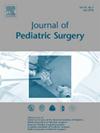巨结肠疾病中的微环境TFPI2: ENCC发展的机制
IF 2.5
2区 医学
Q1 PEDIATRICS
引用次数: 0
摘要
背景:巨结肠病(HSCR)是儿科外科中相对常见的疾病,其特征是由于肠内肠神经嵴细胞(ENCCs)定植缺陷导致肠神经节细胞缺失。本研究旨在探讨肠道微环境的改变,重点关注组织因子途径抑制剂2 (TFPI2)作为潜在的致病因素。方法:分析HSCR患者和胎鼠肠道的转录组学数据,确定候选基因。通过qRT-PCR、免疫组织化学和Western blotting验证TFPI2的表达。采用CCK-8、EdU、流式细胞术、Western blotting、实时细胞观察等方法,将重组TFPI2蛋白应用于ENCC培养,评估其对细胞增殖、凋亡和迁移的影响。对转录组数据进行KEGG和GSEA分析以探索可能的机制,并使用PI3K-AKT通路激动剂IGF-1评估功能恢复。结果:TFPI2被确定为与HSCR相关的一个新的微环境因子。其在HSCR患者的神经节段和E14.5胎鼠肠道中的表达显著升高。TFPI2抑制ENCC增殖和迁移,同时促进细胞凋亡,可能通过下调PI3K-AKT信号通路。IGF-1部分挽救了tfpi2诱导的增殖、迁移和凋亡效应。结论:本研究确定TFPI2是通过抑制PI3K-AKT信号通路导致HSCR中ENCC功能障碍的一个新的微环境因子。这些发现为HSCR的发病机制提供了新的见解,并表明TFPI2可能是一个潜在的治疗靶点。本文章由计算机程序翻译,如有差异,请以英文原文为准。
Microenvironmental TFPI2 in Hirschsprung disease: Mechanisms in ENCC development
Background
Hirschsprung disease (HSCR) is a relatively common disorder in pediatric surgery, characterized by the absence of enteric ganglion cells due to defective colonization of enteric neural crest cells (ENCCs) in the intestine. This study aims to investigate alterations in the intestinal microenvironment, focusing on the tissue factor pathway inhibitor 2 (TFPI2) as a potential pathogenic factor.
Methods
Transcriptomic datasets from HSCR patients and fetal mouse intestines were analyzed to identify candidate genes. TFPI2 expression was validated by qRT-PCR, immunohistochemistry, and Western blotting. Recombinant TFPI2 protein was applied to ENCC cultures to evaluate its effects on proliferation, apoptosis, and migration, using CCK-8, EdU, flow cytometry, Western blotting, and real-time cell observation. KEGG and GSEA analyses of transcriptomic data were conducted to explore potential mechanisms, and functional rescue was assessed using the PI3K-AKT pathway agonist IGF-1.
Results
TFPI2 was identified as a novel microenvironmental factor associated with HSCR. Its expression was significantly elevated in the aganglionic segments of HSCR patients and in the intestines of E14.5 fetal mice. TFPI2 inhibited ENCC proliferation and migration while promoting apoptosis, likely via downregulation of the PI3K-AKT signaling pathway. IGF-1 partially rescued TFPI2-induced effects on proliferation, migration, and apoptosis.
Conclusion
This study identifies TFPI2 as a novel microenvironmental factor contributing to ENCC dysfunction in HSCR by inhibiting the PI3K-AKT signaling pathway. These findings provide new insights into the pathogenesis of HSCR and suggest that TFPI2 could be a potential therapeutic target.
求助全文
通过发布文献求助,成功后即可免费获取论文全文。
去求助
来源期刊
CiteScore
1.10
自引率
12.50%
发文量
569
审稿时长
38 days
期刊介绍:
The journal presents original contributions as well as a complete international abstracts section and other special departments to provide the most current source of information and references in pediatric surgery. The journal is based on the need to improve the surgical care of infants and children, not only through advances in physiology, pathology and surgical techniques, but also by attention to the unique emotional and physical needs of the young patient.

 求助内容:
求助内容: 应助结果提醒方式:
应助结果提醒方式:


